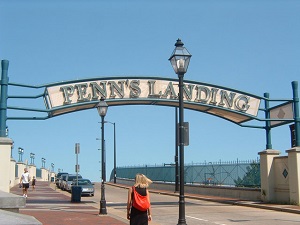Penn's Landing

William Penn's "greene country towne" has finally become a reality here.
The area today known as Penn's Landing stretches along the Delaware River for about 10 blocks from Vine Street to South Street, and encompasses the spot where William Penn, Philadelphia's founder, first touched ground in his "greene country towne." After Penn's arrival, this area quickly became the center of Philly's maritime soul and the city's dominant commercial district. Today, Penn's Landing is a riverside park where Philadelphians gather in the summer to hear music and on December 31 to usher in the New Year.
A SHORT HISTORY OF PENN'S LANDING
William Penn first sailed up the Delaware River in the fall of 1682 aboard the ship Welcome, an aptly named vessel, for in Penn's progressive vision of his colony, all religions would be welcome to pray as they pleased. Penn arrived in Philadelphia by barge from the downriver town of Chester where the Welcome had moored. He alit near a tidewater basin called the Dock fed by a creek of the same name. At the time of Penn's arrival, the area was inhabited, though sparsely, by some landowners in his "holy experiment," as well as by Swedes, Dutch, and Indians. Many of these locals gathered to welcome Penn near the Blue Anchor Tavern, an inn being built along Dock Creek.
Nineteenth-century historian John Fanning Watson, author of the nonpareil "Annals of Philadelphia and Pennsylvania," believed that the landing of Penn in Philadelphia rivaled the landing of the Pilgrims at Plymouth Rock in importance and should have been similarly canonized. Writing in 1842, a time when the Penn's Landing area was a web of wharves and commerce, he rhapsodized fancifully about what Penn might have seen in 1682: "the creek adorned with every grace of shrubbery and foliage, and beyond it...a few of the natives' wigwams, intermixed among the shadowy trees."
Penn himself, mindful of the salubrious effect of greenery and open space within a city, had intended to have a tree-lined promenade planted along the area today named for him. Economics dictated otherwise.
THE CAVE DWELLERS
Not many pioneering settlers had houses waiting for them upon their arrival. Some early purchasers into Penn's dream dug caves into the high banks along the Delaware River to dwell in while their houses were being built. Francis Daniel Pastorius, an early abolitionist and founder of the historic Germantown section of Philadelphia, is known to have been one such cave dweller. Other cave dwellers were not so reputable. In 1685, the town's Grand Jury objurgated Joseph Knight, for "suffering drunkenness and evil orders in his cave"; and several debauched persons were also reproved for condoning drinking houses. Later Philadelphia memoir-keepers alluded to members of the world's oldest profession conducting their form of commerce in these caves as well.
According to historian Watson, once the settlers' houses and businesses were built, they ended up being a bit closer to the river than Penn had intended when the city was laid out. Further, the valuable plots of land near the river were subdivided, and Penn's concept of a city with spacious, green-covered lots was forsaken.
Penn's surveyor, thomas Holme, laid out Philadelphia in a 1,200 acre rectangular manner spreading west from the Delaware River to the Schuylkill River. Clearly, though, the land along the Delaware including the Penn's Landing area was the most valuable. Maritime trade fast became the backbone of the nascent city's economy. Many captains, riggers, sailors, shipbuilders, and ship-owners worked and lived hard on the river.
EARLY ECONOMY
In Philadelphia's early days, farmers and manufacturers of raw materials filled schooners and brigantines with goods headed for England. Colonists, under English sovereignty, were forced to export goods only to the mother country. The King saw the colonies as a natural market for England's own manufacturing, and an exploitable source of raw material and foodstuffs. By the 1720s an armada of British ships brought wool, linen, nails, a variety of metals — even gunpowder — into the busy Philadelphia waterfront. A 1720 painting by Peter Cooper, the earliest work of art depicting an American city, portrays a flotilla of ships on the Delaware dotted by docks and Philadelphia burgeoning with houses.
TAX-EVASION
The diligent colonists found they could produce much more than they could sell to England. Thus, illegally exported lumber, livestock, crops, and tobacco found outlets in non-British ports. Those willing to run the risk of evading British tax patrols often made high returns on their money.
Over time, the wealthiest merchants came to own the most valuable land along the river in order to facilitate their shipping interests. Penn had hoped to retain a parcel of high-banked land along the Delaware for himself, but poor financial straits caused the city's founder to sell out to mercantile interests. Penn's rosy notion of an arbored riparian quay gave way to an ocean of mercantile commotion.
Shipping continued to play a very important role in the city into the 20th century. Even today, you find tankers and freighters docked farther down the river.
PENN'S LANDING TODAY
It took about 300 years, but Penn's dream of a tree-lined riverfront promenade finally came to fruition. Starting in 1967, the city began to redevelop the area's dilapidated docks into a recreation park along the river. Walkways were put in, an amphitheater was built, a World Sculpture Garden installed — and finally, trees were planted along the river.



